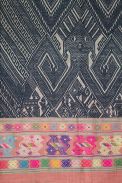Exhibition of Phaa Tumm from Laos
From 26 july to 3 august 2013 - 10.00 am 18.00 pm
Laos Textiles: the Phaa tuum
The phaa tuum are strips of special and elegant multifunctional fabric used by women either as a clothing to wrap around the shoulders in the cool season, or as a practical and lightweight summer blanket. They were also used as baby carriers to strap kids on the mother’s back.
Men use phaa tuum especially when traveling outside the village, as practical and light cloth from multiple uses.
The phaa tuum were woven by the women of the family at home, using only:
- cotton or silk locally produced, hand-spun in the family
- local dyes from plant, mineral or animal origin
- the dying process was carried out "yarn" and applied prior to weaving
These textiles are usually formed by a long rectangular strip of fabric characterized by the division of the piece in three distinct sections:
- a small clear area of natural color, without decorations, which indicates the "top" area of the fabric, to be used for the head and the pure body parts as well;
- a central section, the widest, always richly decorated with colored yarn on white frame, worked with the technique of extra weft to obtain drawings of different type. These different patterns are frequently combined in the same piece with a complex mix;
- a final red section indicates the area of the fabric to be used in contact of the foot or the impure body parts. The upper part of this red zone is decorated with geometric designs or mythological animal figures.
The most used patterns and their meanings
The wide array of decorations can range from small basic sketches in different arrangements and repeated across the entire middle section, to more complex figurative systems, which combine basic patterns with sophisticated mythological figures. In the latter case, the richness of the decorations in the texture of the design can at times be as complex as to make it difficult even for experienced eyes the identification of individual decorations that make it up.
All the decorations are graphic and symbolic reproductions of:
- actual figures belonging to the plant and animal world,
- geometric shapes, such as rhombus, hooks, spirals, bars, etc..;
- astral figures, like the sun, the moon, the stars, the clouds;
- an endless series of figures from the most symbolic to the most daily used, from the diamond to the house of the spirits, from the keys to the swastikas, from the tops of the roofs to the thick fringes, etc..;
- fantastic and semi-divine beings, belonging to the most ancient myths and ancestral religion, pre-Hindu and pre-Buddhist. They are usually represented in the most important phaa tuum. The figures are all taken from ancient Lao myths and are attributable to the sacred snake (naga) and the river dragons, to the mythical bird, to the elephant and the mythical elephant-lion
- anthropomorphic figures refer to ancestors or mythological giants.
The phaa tuum are an important testimony to the skill and creativity of generations of clever, patient, and reserved women of Laos, who have rendered an ancient and valuable knowledge, with passion and perseverance from mother to daughter. The tragic historical events of the 60s and 70s with the neighboring war in Vietnam have contributed to disperse this heritage, these ancient and precious skills, at least partially lost forever and without possibility of recovery.
Bruno Gentili from “Quaderni asiatici 100” december 2012
